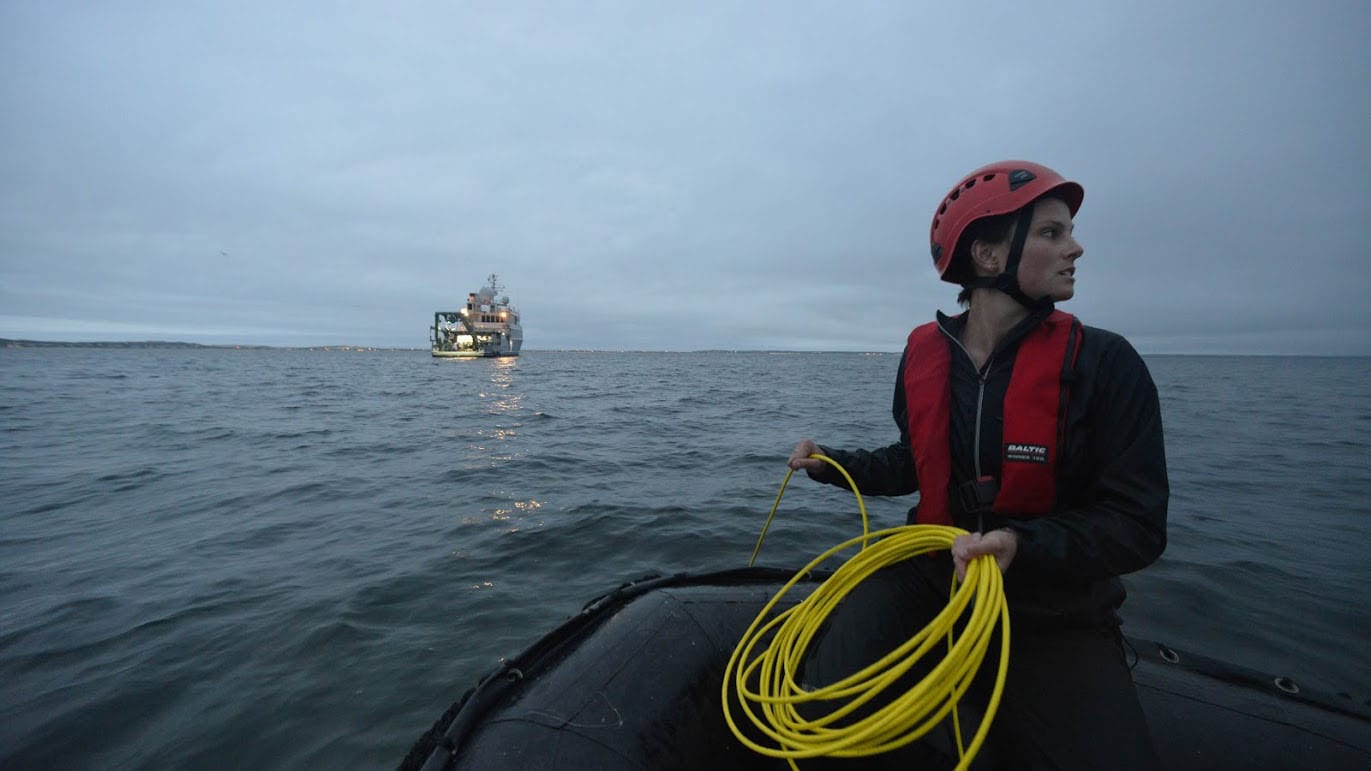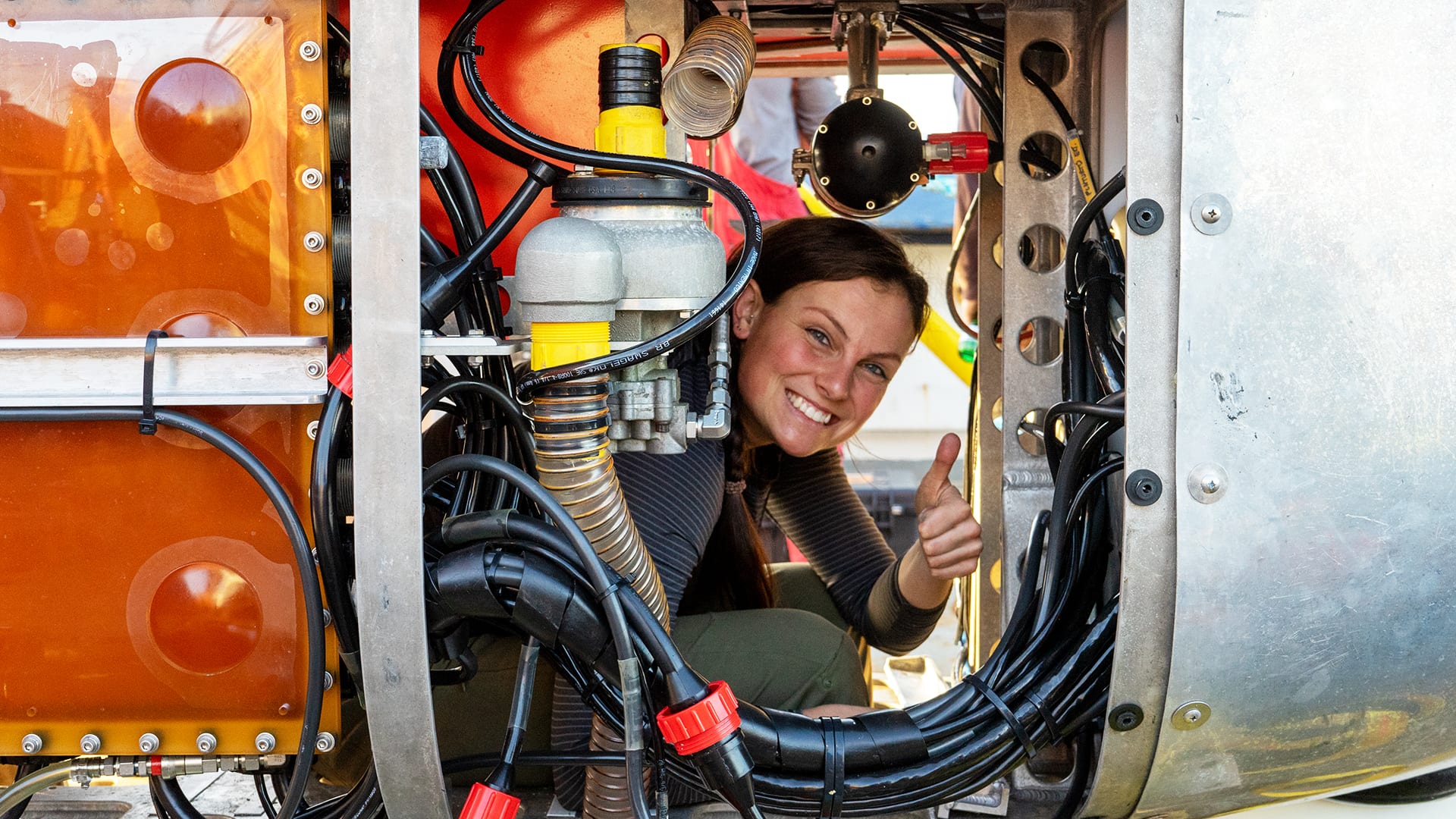Opening our eyes to the deep: Molly Curran
WHOI mechanical engineer discusses the great challenges—and rewards—of designing vehicles for deep-sea exploration
By Toni Parras | March 12, 2020
Molly Curran is a mechanical engineer in WHOI’s Deep Submergence Laboratory. She works on the design and operation of deep-sea robotic systems, including remotely operated vehicles, autonomous vehicles, and deep-sea samplers. She was the institution's first pilot for Mesobot, WHOI’s latest autonomous robot designed to study the midwater realm known as the ocean twilight zone.
How did you originally become interested in science and engineering?
I grew up on a little farm in Pennsylvania, in and on the water pretty much 24/7. My family lived on a lake, and on vacations we would just go to bigger lake. Throughout my childhood my whole family raced jet skis. My dad was the mechanic for our team, and I saw how he put his engineering brain to work to make our skis better and faster. He was a big inspiration for me to see all the cool things you can do being an engineer. My mom and brother are also engineers and they were always coming up with interesting and fun ideas. I’ve always loved science and water, so doing engineering to advance science in the ocean is a dream come true!
What does a typical day look like for you at WHOI?
When I’m in the office, I do mechanical design work, which includes system-level design down to working out the little mechanical details. I do “back of the envelope” ideas all the way through analysis and computer-aided design, then follow through with fabrication, assembly, testing and then operation out at sea. I typically spend weeks at a time out at sea operating deep-sea vehicles, from launch and recovery to fixing components when they fail or break. Going to sea is one of the most incredible aspects of my job—an extremely rewarding facet is seeing something you put hard work into designing get deployed into the ocean.
Why work with WHOI? What does WHOI have that other similar institutions don’t?
WHOI is at the leading edge of ocean research. We push the boundaries of engineering and technology in an exciting direction, whether researching climate change or discovering life on different planets (some of the projects I work on are tied with NASA). The work we do is for a good cause to better our world (and other worlds) for future generations. I’m very proud to work here.
What is the most exciting thing you’ve accomplished during your career at WHOI?
I’ve been lucky enough to be involved with two vehicles (Orpheus and Mesobot) where I was part of the team from initial design all the way through to the first cruise. It’s so rewarding when you go out with a brand-new vehicle and put it in the open ocean for the first time. It’s also terrifying since there are always a lot of possibilities for things to go wrong. But working with a vehicle from the very start and working alongside brilliant team members gives you confidence the vehicle will operate well and evolve into something great.

When you work in the field, where is your favorite place to go?
The Arctic. It’s incredible—so mighty and harsh yet beautiful and serene at the same time. But it’s very hard environment to work in. In most places we operate, when we’re done exploring, the vehicle floats to the surface and we just go pick it up. In the Arctic, to recover the vehicle it must come back to a small hole in the ice that is constantly moving and closing. On an expedition in 2019 we were aiming to explore a hydrothermal vent, but there was ice parked over the vent for days so the ship couldn’t get to the site. Working on deck is also much more difficult. Things that wouldn’t be a factor in warmer areas are an issue, like sensors freezing and cracking or ice jamming mechanisms causing them to fail.
The Arctic is also just a striking place. It opens your eyes to climate change, the idea that maybe someday that beautiful ice won’t exist. That’s just another driving factor to improve our scientific knowledge of what’s going on.
What is the future of oceanography, and how does your work contribute to that?
So much of the ocean is unexplored and in order to help sustain the wellbeing of the ocean we need a deeper understanding of it. That means being able to explore parts of the ocean that were previously unreachable, like the hadal zone which is the deepest part of our ocean. We’re designing the tools to allow scientists to access the ocean and learn about it, and then come up with solutions. Ultimately, the technology we design for the deep ocean may also one day be used in other liquid oceans throughout our solar system.

